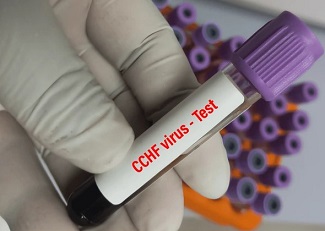Nikhil Prasad Fact checked by:Thailand Medical News Team Apr 29, 2024 11 months, 3 weeks, 6 days, 9 hours ago
Medical News: Crimean-Congo Hemorrhagic Fever (CCHF) is a viral disease that has recently made its presence felt in Spain, sparking concerns about its spread and management. The first case of CCHF for the year 2024 detected in the country involves an elderly man who is currently undergoing treatment at the Salamanca University Hospital. This
Medical News report delves into the details of this case, including the epidemiological aspects, clinical manifestations, preventive measures, and the broader implications of this emerging infectious disease.
 Crimean-Congo Hemorrhagic Fever Infection Detected In Spain
Confirmation and Management of the Case
Crimean-Congo Hemorrhagic Fever Infection Detected In Spain
Confirmation and Management of the Case
According to local media news reports, the confirmation of the Crimean-Congo Hemorrhagic Fever CCHF case in Spain came after rigorous analyses conducted at the National Microbiology Center of the Carlos III Health Institute. The patient's condition, although severe, is stable, thanks to the prompt adoption of protocolized epidemiological and care measures at the Salamanca University Hospital. The General Directorate of Public Health and its Epidemiology Service have been actively involved in overseeing the patient's treatment and implementing necessary isolation protocols.
https://www.salamanca24horas.com/local/se-confirma-primer-caso-fiebre-hemorragica-crimea-congo-en-salamanca_15112100_102.html
https://www.laregion.es/articulo/valdeorras/virus-crimea-congo-llega-bierzo-pone-galicia-alerta/202404260315241289795.html
Epidemiological Surveillance and Contact Tracing
A crucial aspect of containing the spread of CCHF involves identifying and monitoring individuals who may have come into contact with the infected person. The Epidemiology Section of the Territorial Health Service of the Junta de Castilla y León, in collaboration with healthcare professionals from the Salamanca University Hospital, has diligently carried out contact tracing efforts. This meticulous approach is essential in preventing further transmission of the disease within the community.
Understanding Crimean-Congo Hemorrhagic Fever
Crimean-Congo Hemorrhagic Fever is caused by the Nairovirus and primarily transmitted through tick bites. The World Health Organization (WHO) highlights its potential severity, with a fatality rate ranging from 10 to 40 percent. While traditionally found in regions like Africa, the Balkans, the Middle East, and Asia, there are concerns about its geographical expansion, possibly influenced by climate change.
Clinical Features and Diagnosis
The clinical presentation of CCHF encompasses a range of symptoms, starting from mild febrile illness to severe hemorrhagic manifestations. Patients may experience hea
daches, high fever, joint pain, gastrointestinal symptoms, and characteristic signs such as red eyes and petechiae. In severe cases, jaundice, mood disturbances, and profound bleeding tendencies can occur, necessitating prompt medical intervention.
Preventive Strategies and Public Awareness
Given the vector-borne nature of CCHF, preventive strategies play a pivotal role in reducing the risk of transmission. The Government of Castilla y León has emphasized the importance of protecting against tick bites through appropriate clothing and footwear when venturing into tick-prone areas. Immediate removal of ticks by healthcare professionals is recommended upon bite detection. The Ministry of Health portal offers valuable resources for understanding CCHF and following the necessary protocols.
Global Concerns and Climate Impact
The emergence of CCHF in Spain underscores broader global concerns regarding infectious disease spread. Climate change has been implicated in the shifting geographical patterns of vector-borne diseases, potentially bringing diseases like CCHF closer to regions previously unaffected. This phenomenon necessitates enhanced surveillance, preparedness, and collaborative efforts at the national and international levels.
Conclusion: Addressing the Challenges Posed by CCHF
The detection of Crimean-Congo Hemorrhagic Fever in Spain serves as a stark reminder of the ongoing challenges posed by emerging infectious diseases. Effective surveillance, rapid diagnosis, and robust public health interventions are essential in mitigating the impact of such diseases on individuals and communities. Continued research, collaboration, and public awareness efforts are crucial in addressing the multifaceted aspects of CCHF and similar threats in the future.
For the latest on Crimean-Congo Hemorrhagic Fever, keep on logging to Thailand
Medical News.
